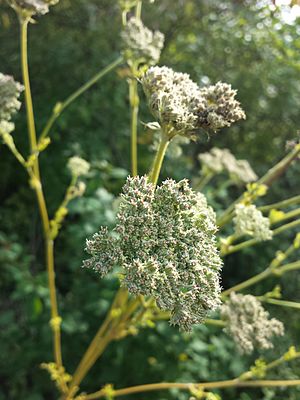Moon carrot facts for kids
Quick facts for kids Moon carrot |
|
|---|---|
 |
|
| Conservation status | |
|
Not evaluated (IUCN 3.1)
|
|
| Scientific classification | |
| Kingdom: | |
| (unranked): | |
| (unranked): | |
| (unranked): | |
| Order: | |
| Family: | |
| Genus: |
Seseli
|
| Species: |
S. libanotis
|
| Binomial name | |
| Seseli libanotis (L.) W.D.J. Koch
|
|
| Synonyms | |
|
|
Seseli libanotis, often called moon carrot or mountain stone-parsley, is a type of herb. It belongs to the Seseli group within the carrot family, known as Apiaceae. This plant naturally grows across a large area of Eurasia.
Contents
What the Moon Carrot Looks Like
The moon carrot plant usually grows between 40 to 120 centimeters (about 1.3 to 4 feet) tall. It has straight stems that branch out. Its leaves grow in an alternating pattern along the stem. The lower leaves have stalks, while the upper ones do not. The underside of the leaves is a bluish-green color.
The flowers are small, less than 5 millimeters (0.2 inches) wide. They are white, sometimes with a slight reddish tint. These flowers grow in special clusters called umbels. Each large umbel can have up to sixty flowers. Many smaller umbels also form within the larger ones.
After flowering, the plant produces a flat, brown fruit. This fruit is egg-shaped and slightly hairy. It is usually about 2.5 to 4 centimeters (1 to 1.6 inches) long. Scientists have found three main types (subspecies) of Seseli libanotis.
Where Moon Carrot Grows and Its Life Cycle
The moon carrot is usually a biennial plant. This means it lives for two years. It grows leaves in the first year and flowers, produces seeds, and dies in the second year. Sometimes, it can be a monocarpic perennial. This means it lives for more than two years but flowers only once before it dies.
This plant blooms during July and August. It prefers places with a mild climate. You can find it naturally across much of northern and central Eurasia. Its range stretches from England and Scandinavia all the way to Siberia. It is also common in the Carpathian Mountains.
Moon carrot likes rocky areas, grassy slopes, or places with shrubs. It grows best in dry soil that drains water well. In Britain, it is only found in special protected areas. These areas are called SSSIs. There, it grows on chalky ground in the Chiltern Hills and South Downs. The plant has also been brought to Maryland in the United States. In some places, S. libanotis is considered an invasive species. This means it can spread quickly and harm native plants.
The IUCN has not yet studied this plant globally. However, it is rare in Britain. Because of this, it is listed as "Near Threatened" there.
Moon Carrot and Rust Fungus
The moon carrot is a host plant for a special kind of fungus. This fungus is called Puccinia libanotidis, or moon carrot rust. It is a type of rust fungus. For a long time, people thought this fungus had disappeared from Britain. It had not been seen since 1946. But in 2009, scientists from Kew Gardens rediscovered it.
Uses of Moon Carrot
Both the leaves and the root of the moon carrot can be eaten. The plant is also helpful for making honey. People have used it in traditional medicine for a long time. Some studies suggest that S. libanotis and other plants in its group might have natural properties. These properties could help fight germs and protect cells from damage.
See also
 In Spanish: Seseli libanotis para niños
In Spanish: Seseli libanotis para niños

